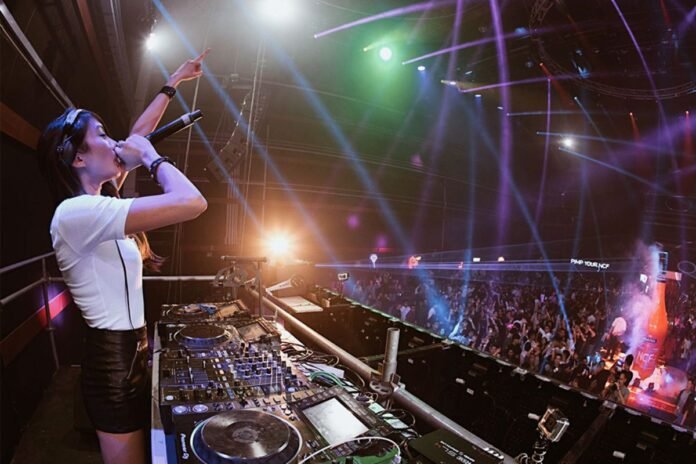EDM has gone from an underground genre to a chart-topping phenomenon.
Once a niche genre, Electronic Dance Music (EDM) has gone from strength to strength in capturing the mainstream music market.
EDM is produced primarily for dance-based entertainment environments like nightclubs, “most often presented in the context of a DJ mix,” according to Magnetic Magazine, an EDM culture blog.

On Singapore’s radio station 987FM’s annual Top 100 chart for 2016, 4 out of the top 10 songs belonged to the EDM genre, with the overall top 3 songs from The Chainsmokers, Calvin Harris, and Major Lazer. In contrast with the 987FM Top 100 chart in 2015, only 2 out of the top 10 songs were from this genre. These charts are based on radio airplay, indicating the growing EDM preference among the local youth.
A survey by The UrbanWire found that 80 percent of the 130 respondents aged 18 to 35 listen to EDM. Most of these respondents feel that EDM is “nice and catchy”, and attributed its popularity to clubs, festivals, the shift in pop culture, and radio airplay.
According to Ms Desireen Law, senior digital executive at Warner Music Singapore, the crowd size for the annual dance music festival ZoukOut has doubled from 2010 (28,000 people) to 2014 (50,000 people). Ultra Music Festival, dubbed the world’s “premier electronic music festival”, has also made Singapore a stop last year.
She said, “I would like to say it’s globalization of culture through media and technology, rather than Western cultural imperialism, that brought EDM to Singapore. Electronic music wouldn’t be as big as it is today without YouTube videos of music festivals from around the world, Spotify, and Soundcloud providing a wide range of electronic music to enjoy on the go.”

Ms Law added that international DJs are the biggest influencers.
“I think the pioneers are DJs like Armin van Buuren, Steve Aoki, David Guetta, Above & Beyond, etc. Then DJs like Alesso, Avicii, Skrillex, and Diplo came along and mixed things up in unconventional ways, and dance music suddenly enjoys radio airplay automatically after they’re released – and it gave rise to the coolest artistes now like Galantis, Kygo, Zedd, and Dillion Francis.”
Lawrence Yap, 22, has been interested in the DJ scene for a while. “I was inspired when I went to Ultra Music Festival last year and saw how hyped up the crowd was. Before that, I had always looked at YouTube videos of festivals such as Tomorrowland and always thought that the ‘DJ spinning thing’ was cool,” he said. I don’t know where to start, though. It was difficult trying to pick it up from online tutorials, and classes are expensive.”

Lawrence is one of the 76.8% of respondents in UrbanWire’s survey who would learn how to DJ. The top two reasons cited in our survey are “It’s cool” and “I love music.”
Kate Yong, also known as DJ Tinc, a Singaporean DJ who owns her own studio and record label This Beat Is Sick, agrees that the change in technology over the years made EDM popular. The 26-year-old said: “In the past 10 years, technology has given us a lot of opportunities to make different kinds of music. I think that is where EDM came about and became popular among people, because it’s easier to produce from home with just your laptop, and budget-wise.”
At This Beat Is Sick, DJ Tinc holds classes for interested students and has taught students ages 14 to 30. “Over the past 3 to 4 years, there was a high demand in DJ classes because of the rise in music festivals,” she said. “I think it’s because in the recent years, the government has become more open to music festivals and so they (Singaporeans) are more exposed to EDM as it is the trend.”
Others, such as Timothy Yip, 20, who goes by the stage name DJ T! mo, picked up the skill when he was 13. Of course, it wasn’t easy. He has spent nearly $700 on his software and equipment, and the final-year student is part of Ngee Ann Polytechnic’s DJ interest club.
“During recruitment, around 80 to 100 people sign up. This figure then drops to 5 to 10 who will stick around for over a year,” he said. I would say that there have been more people interested in DJ-ing in recent years, but they are often only interested in the glitz and glamour that is often associated with it and not interested in the art itself.”
The music scene in Singapore, especially the EDM scene, seems more recognized today. Recently, Manfred Lim, a Singaporean who performs as Myrne, was signed to American producer Diplo’s label. An EDM trio, Trouze, is made up of two Singaporeans—Tat Tong and Declan Ee—whose songs have since charted on Billboard. They have also worked with Troye Sivan and Vanness Wu.

It’s simple to pick up this skill—self-taught, in classes, or online. “You can do it from home with just your laptop. It’s easily accessible for a lot of people—you can just buy a mini keyboard or a laptop—it’s all technology. I can create guitar, violin, and drum sounds just by touching the keyboard,” DJ Tinc advised.
“All of us started from nothing, it’s just a lot of time and effort put in and how much you are willing to put in. If Gentle Bones can make it in Southeast Asia, why can’t a producer? It’s the same concept, it’s just a different way to express music.”

